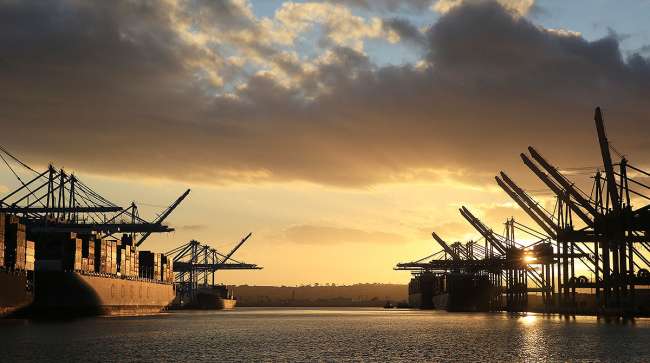Senior Reporter
Port Association Critical of Proposed Funding Cuts

[Stay on top of transportation news: Get TTNews in your inbox.]
American Association of Port Authorities is criticizing President Donald Trump’s fiscal 2021 budget because of what the association says are the cuts to funding for the nation’s ports.
“We’re very apprehensive about the president’s fiscal 2021 budget,” said Chris Connor, CEO of the Alexandria, Va.-based organization. “Adequate federal investments into U.S. port-related infrastructure, on the landside and the waterside, are crucial for the safe, efficient movement of goods so the nation can remain globally competitive, and this budget doesn’t get us there.”
AAPA says it primarily is concerned that three federal programs that support the ports are on the chopping block or will face cuts.

Connor
The U.S. Department of Transportation’s Port Intermodal Infrastructure Program, which began in 2019 and which Congress funded at $225 million in the last budget, would be eliminated. The Department of Homeland Security’s Port Security Grant Program. Congress funded that program at $100 million last year, and it would be reduced to $36.4 million in the next fiscal year.
Additionally, Trump has proposed cutting the Environmental Protection Agency’s budget by 31%.
The EPA budget contains funding for the Diesel Emissions Reduction Act grants, which would be slashed by 89% over fiscal 2020 enacted levels.
AAPA says the grants have helped reduce port-related diesel emissions in communities near those facilities, and the ports have used the money to purchase pollution-reducing equipment.
“Proposed for the budget chopping block is the USDOT’s Port Intermodal Infrastructure Program, which began as the Port Infrastructure Development Grants program in [fiscal 2019],” Connor said. “By the end of this fiscal year, the PIIP will have awarded more than $500 million in grants to improve the safety, efficiency and reliability of multimodal movement through our nation’s seaports."
In part two of a two-part exploration of autonomous technology today, our latest RoadSigns podcast revisits conversations with Chuck Price of TuSimple and Ognen Stojanovski of Pronto.ai. Hear them discuss a palatable Level 2 version of trucking autonomy. Listen to a snippet above, and to hear the full episode, go to RoadSigns.TTNews.com.
In 2016, AAPA conducted a survey and found U.S. ports and their private-sector partners planned to spend nearly $31 billion annually through 2020 to improve the infrastructure outside the ports’ jurisdiction by adding roads, rail lines, bridges, tunnels and navigation channels.
“Activities at U.S. seaports account for more than a quarter of the nation’s economy, support over 31 million American jobs and generate more than $378 billion a year in federal, state and local tax revenue,” Connor said. “It’s vital the federal government uphold its end of the partnership with ports to ensure the country has a 21st-century goods movement system in place.”
The association also said it is displeased with the funding level for dredging and channel maintenance that will be available to the U.S. Army Corps of Engineers.
“Led by a 20% increase in construction funding, the president’s [fiscal 2021] budget for the U.S. Army Corps of Engineers coastal navigation program would rise 10% compared to his [fiscal 2020] budget request. While AAPA acknowledges this increase, the amount is still nearly 40% less than [fiscal 2020’s] appropriated level.”
However, some ports are receiving money for dredging projects that are underway.

Recently, the Port of Savannah’s 30 cranes were busy working seven vessels simultaneously along Garden City Terminal’s 10,000-foot dock. (Jeremy Polston/Georgia Ports Authority)
The Port of Savannah is slated to receive $93.6 million to continue deepening the harbor and an additional $34.6 million to modernize Berth 1 so it is capable of handling the largest ships now transporting items across the oceans.
This is the last stage of the project to deepen 22 miles of the inner harbor shipping channel to 47 feet from 42 feet, from Jones Island to the Garden City port. This phase began in October, and officials estimate it could be completed late this year or early next year.
The first phase of the deepening of the outer harbor, from Fort Pulaski National Monument to 19 miles into the Atlantic Ocean, was finished in March 2018.
The entire 41-mile project is estimated to cost $973 million, and the state of Georgia has spent $300 million.
“The Port of Savannah is the third-largest and fastest-growing port in the entire country, and it consistently shatters records for container cargo moved,” U.S. Sen. David Perdue (R-Ga.) said in a statement. “Once completed, [Savannah Harbor Expansion Project] will contribute $282 million to our economy each year. This is huge news for Georgia and will give our country a competitive edge across the world.”
Want more news? Listen to today's daily briefing:




